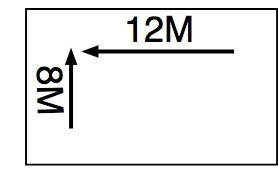If you’re planning to measure your room before buying wood flooring (or any other type of flooring), you’ll need three basic items. The first is a tape measure, the second is a piece of paper and finally a pen. Ideally you should choose a 10 or 20 meter tape measure and if possible recruit a friend to help you as this will make your job much quicker and probably more accurate.
If your room is square or rectangular, the job of measuring your room couldn’t be simpler. All you need to do if it’s square is measure the length and breadth (just to check) and multiply one by the other. So, if, for example your room is 10m x 10m, you have 100m2 of floor. If your room is rectangular, again measure the length and the breadth and multiply one by the other. So, a room which is 8m long and 12 m wide is 96m2.
For a room shaped like this:

You need to multiply 12m x 8m = 96m2
Then you need to work out your waste factor of 8% ie. 96m2 x 8% = 7.70m2
So the total flooring you need to order is 96m2 + 7.70m2 = 103.70m2
If you decide to measure your room and it’s not a regular shape, this is where things gets slightly more complicated. For example, if you have an L-shaped room you should try to create a rough sketch of the floor layout. Once you’ve done that, identify places where you can split the room into nice, clearly identifiable squares or rectangles. In order to illustrate, in an L-shaped room for example, you should be able to create either two rectangles or perhaps a rectangle and a square, each of which you can measure in the same way as described above and then add the two measurements together to give you the total surface of your room.
For an L-shaped room shaped like this, separate the room into two rectangles to measure:
Part A = 3m x 5m = 15 m2
Part B = 10m x 6m = 60 m2
Then add the two parts together ie. 15m2 + 60 m2 = 75 m2
Then you need to work out your waste factor of 8% ie 75m2 x 8% = 6m2
So the total flooring you need to order is 75 m2 + 6 m2 = 81 m2
To measure really odd shaped rooms, always try to adopt this approach of splitting your room into “bite sized” squares or rectangles and measuring each one individually and adding the results together.
Here’s a few “top tips” to bear in mind when you’re measuring your room for flooring:
1. No matter what type of flooring your planning, you’re best to measure in metres because that’s the measurement your flooring will be sold in.
2. Always add 8% to your total measurement for wastage.
3. Measure into your doorframes because your flooring will generally be expected to finish under your door.
4. Don’t forget to make allowances in your measurements for fireplaces, alcoves, recesses and cupboards.
—
FAQ
What are the basic items required to measure a room for wood flooring?
To measure a room for wood flooring, you will need three basic items: a tape measure, a piece of paper, and a pen. A 10 or 20-meter tape measure is ideal, and having a friend to help will make the job quicker and likely more accurate.
How do you measure a square or rectangular room for wood flooring?
For a square or rectangular room, measure the length and breadth and multiply one by the other. For example, a room that is 10m x 10m is 100m2 of floor. It’s the same process for a rectangular room.
How do you measure an irregular or L-shaped room for wood flooring?
For an irregular or L-shaped room, create a rough sketch of the floor layout and identify places where you can split the room into clearly identifiable squares or rectangles. Measure these areas individually and add the measurements together to give the total surface area of your room.
What are some top tips to remember when measuring a room for flooring?
When measuring a room for flooring, remember these tips: always measure in meters as your flooring will be sold in this measurement, add 8% to your total measurement for wastage, measure into your doorframes because your flooring will typically finish under your door, and make allowances in your measurements for fireplaces, alcoves, recesses, and cupboards.
How do you calculate the total flooring you need to order?
After measuring your room, multiply the area (in m2) by 8% to calculate your waste factor. Add this value to your total measurement to get the total flooring you need to order.









